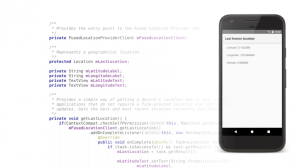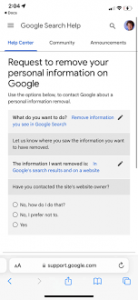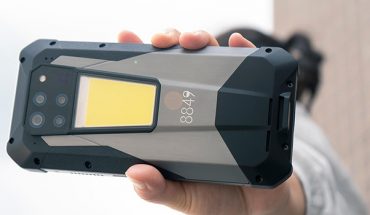If there’s an accident or medical emergency, you want first responders to find you fast.
If there’s unwanted personal information about you popping up in web searches, you want to remove it easily.

Most emergency calls in Canada originate from a mobile device; so Google has added emergency location services to its Android mobile operating system.
With recent updates to Google’s Android operating system now available in Canada, you can have both. There’s a powerful new emergency location tool and a way to request personal information be removed from search results.
If you must make an emergency call from a mobile device (and more than 80 per cent of emergency calls in Canada originate on a mobile phone) that uses traditional (that is, older) location technologies, first responders can often be challenged by search areas too large or imprecise to be useful.
Google says the Emergency Location Service (ELS) function on Android phones can help emergency services locate a needy caller more quickly, accurately, and securely. ELS uses a combination of the many location technologies available to apps on newer phones, including Wi-Fi, GPS, and cellular signals, to determine a more accurate and therefore more useful emergency location, whether indoors and outdoors.
By implementing a new technology known as advanced mobile location (AML), shortcomings in the traditional system are being addressed.
Android ELS activates only when 9-1-1 is dialed; there’s no other special hardware or apps that are needed on either end of the call.

ELS uses a combination of location technologies already on your phone (all those Wi-Fi, GPS, and cell tower coordinates bouncing around) to calculate precise location.
ELS uses a combination of location technologies already on your phone (all those Wi-Fi, GPS, and cell tower coordinates bouncing around) to calculate a precise location on the caller’s device and securely and privately transmit the information to emergency services partners.
Google says the first responder partners the only ones to get the precise location information; it is not seen or handled by Google.
ELS is now active in Canada, across all Canadian provinces and territories where 9-1-1 is available, regardless of mobile provider.
ELS data is provided directly to E9-1-1 and NG9-1-1 Public Safety Answering Points (PSAP) via the existing 9-1-1 infrastructure, with no changes required.
E9-1-1 and NG9-1-1 are location-based telecom protocols, with E9-1-1 using a table-based system filled with civic address ranges and related public safety data that are used to send emergency calls to the appropriate response coordinator. NG911 standards are more advanced than the “outdated 911 infrastructures”, gathering additional details about the caller, the location, the phone and so on.
There are still areas in Canada where 9-1-1 call location information is not directly shared by telecommunications companies, such as Newfoundland & Labrador and the Northwest Territories, so Google partnered with RapidSOS, a U.S.-based intelligent location services provider, to make location data available to Emergency Service Providers.
Google (and Apple, for that matter) are regularly mapping cellular towers and identifiable Wi-Fi hot spots, among other locations in the telecom infrastructure. That data is provided to their Android- or iOS-based smartphones on an ongoing basis, and of course it is used to determine the location of a smartphone, also on an ongoing basis.
The new ELS provision in Canada is part of an initiative supported by the Canadian Radio-television and Telecommunications Commission (CRTC) Emergency Services Working Group (ESWG) and its designated partners Bell Canada, and TELUS Communications Inc. (TCI).
Google ELS is available free for all Android phones (version 5 or newer devices with Google Play services support—no activation required) in use in Canada. The tool provides access to the user’s device language settings, so first responders can ask for a translator if needed. Users can turn off ELS in software settings at any time.

Results About You can monitor the Web for search results that contain your personal contact information, thus enabling you to immediately request its removal.
In an emergency, you certainly want your location known. But there are many reasons why you wouldn’t want your data to be public. Privacy and security among them.
So Google is also rolling out in Canada a tool that makes it easier to find and request the removal of personal contact information, such as personal phone numbers, home address or email, from Search results.
Results About You can monitor the Web for search results that contain your personal contact information, thus enabling you to immediately request its removal.
There’s a dashboard feature to let you know if web results with your contact information are showing up on Search, and there’s an ability to request those results be removed from Google right in the tool.
If new results from the web containing your contact info pop up in Search, you will be notified.
And in some cases, being notified may be as good as being rescued.
-30-



